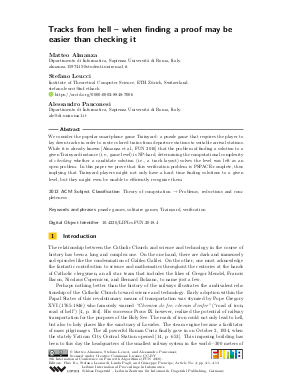Tracks from hell - when finding a proof may be easier than checking it
Authors
Matteo Almanza,
Stefano Leucci  ,
Alessandro Panconesi
,
Alessandro Panconesi
-
Part of:
Volume:
9th International Conference on Fun with Algorithms (FUN 2018)
Part of: Series: Leibniz International Proceedings in Informatics (LIPIcs)
Part of: Conference: International Conference on Fun with Algorithms (FUN) - License:
 Creative Commons Attribution 3.0 Unported license
Creative Commons Attribution 3.0 Unported license
- Publication Date: 2018-06-04
File

PDF
LIPIcs.FUN.2018.4.pdf
- Filesize: 0.83 MB
- 13 pages
Document Identifiers
Subject Classification
ACM Subject Classification
- Theory of computation → Problems, reductions and completeness
Keywords
- puzzle games
- solitaire games
- Trainyard
- verification
Metrics
- Access Statistics
-
Total Accesses (updated on a weekly basis)
0Document
0Metadata
Abstract
We consider the popular smartphone game Trainyard: a puzzle game that requires the player to lay down tracks in order to route colored trains from departure stations to suitable arrival stations. While it is already known [Almanza et al., FUN 2016] that the problem of finding a solution to a given Trainyard instance (i.e., game level) is NP-hard, determining the computational complexity of checking whether a candidate solution (i.e., a track layout) solves the level was left as an open problem. In this paper we prove that this verification problem is PSPACE-complete, thus implying that Trainyard players might not only have a hard time finding solutions to a given level, but they might even be unable to efficiently recognize them.
Cite As Get BibTex
Matteo Almanza, Stefano Leucci, and Alessandro Panconesi. Tracks from hell - when finding a proof may be easier than checking it. In 9th International Conference on Fun with Algorithms (FUN 2018). Leibniz International Proceedings in Informatics (LIPIcs), Volume 100, pp. 4:1-4:13, Schloss Dagstuhl – Leibniz-Zentrum für Informatik (2018)
https://doi.org/10.4230/LIPIcs.FUN.2018.4
BibTex
@InProceedings{almanza_et_al:LIPIcs.FUN.2018.4,
author = {Almanza, Matteo and Leucci, Stefano and Panconesi, Alessandro},
title = {{Tracks from hell - when finding a proof may be easier than checking it}},
booktitle = {9th International Conference on Fun with Algorithms (FUN 2018)},
pages = {4:1--4:13},
series = {Leibniz International Proceedings in Informatics (LIPIcs)},
ISBN = {978-3-95977-067-5},
ISSN = {1868-8969},
year = {2018},
volume = {100},
editor = {Ito, Hiro and Leonardi, Stefano and Pagli, Linda and Prencipe, Giuseppe},
publisher = {Schloss Dagstuhl -- Leibniz-Zentrum f{\"u}r Informatik},
address = {Dagstuhl, Germany},
URL = {https://drops.dagstuhl.de/entities/document/10.4230/LIPIcs.FUN.2018.4},
URN = {urn:nbn:de:0030-drops-87954},
doi = {10.4230/LIPIcs.FUN.2018.4},
annote = {Keywords: puzzle games, solitaire games, Trainyard, verification}
}
Author Details
References
- Aaron B. Adcock, Erik D. Demaine, Martin L. Demaine, Michael P. O'Brien, Felix Reidl, Fernando Sánchez Villaamil, and Blair D. Sullivan. Zig-zag numberlink is np-complete. JIP, 23(3):239-245, 2015. URL: http://dx.doi.org/10.2197/ipsjjip.23.239.
- Matteo Almanza, Stefano Leucci, and Alessandro Panconesi. Trainyard is NP-hard. Theoretical Computer Science, 2017. URL: http://dx.doi.org/10.1016/j.tcs.2017.09.039.
-
Joseph Culberson. Sokoban is PSPACE-complete. In Proceedings of the 1st International Conference on Fun with Algorithms (FUN'98), volume 4, pages 65-76, 1998.

-
Giuseppe Pasolini dall'Onda and Pier Desiderio Pasolini. Memoir of Count Giuseppe Pasolini. Longmans, Green, and Company, 1885.

- David Eppstein. Computational complexity of games and puzzles. URL: https://www.ics.uci.edu/~eppstein/cgt/hard.html.
- Gary William Flake and Eric B. Baum. Rush hour is pspace-complete, or "why you should generously tip parking lot attendants". Theor. Comput. Sci., 270(1-2):895-911, 2002. URL: http://dx.doi.org/10.1016/S0304-3975(01)00173-6.
- Eric Goles, Pedro Montealegre, Ville Salo, and Ilkka Törmä. Pspace-completeness of majority automata networks. Theor. Comput. Sci., 609:118-128, 2016. URL: http://dx.doi.org/10.1016/j.tcs.2015.09.014.
- Luciano Gualà, Stefano Leucci, and Emanuele Natale. Bejeweled, candy crush and other match-three games are (np-)hard. In 2014 IEEE Conference on Computational Intelligence and Games, CIG 2014, Dortmund, Germany, August 26-29, 2014, pages 1-8. IEEE, 2014. URL: http://dx.doi.org/10.1109/CIG.2014.6932866.
- Luciano Gualà, Stefano Leucci, Emanuele Natale, and Roberto Tauraso. Large peg-army maneuvers. In Erik D. Demaine and Fabrizio Grandoni, editors, 8th International Conference on Fun with Algorithms, FUN 2016, June 8-10, 2016, La Maddalena, Italy, volume 49 of LIPIcs, pages 18:1-18:15. Schloss Dagstuhl - Leibniz-Zentrum fuer Informatik, 2016. URL: http://dx.doi.org/10.4230/LIPIcs.FUN.2016.18.
-
Robert A. Hearn and Erik D. Demaine. Games, Puzzles, and Computation. CRC Press, 2009.

-
Graham Kendall, Andrew J. Parkes, and Kristian Spoerer. A survey of np-complete puzzles. ICGA Journal, 31(1):13-34, 2008.

- Stefan Langerman and Yushi Uno. Threes!, fives, 1024!, and 2048 are hard. In Erik D. Demaine and Fabrizio Grandoni, editors, 8th International Conference on Fun with Algorithms, FUN 2016, June 8-10, 2016, La Maddalena, Italy, volume 49 of LIPIcs, pages 22:1-22:14. Schloss Dagstuhl - Leibniz-Zentrum fuer Informatik, 2016. URL: http://dx.doi.org/10.4230/LIPIcs.FUN.2016.22.
- Neeldhara Misra. Two dots is np-complete. In Erik D. Demaine and Fabrizio Grandoni, editors, 8th International Conference on Fun with Algorithms, FUN 2016, June 8-10, 2016, La Maddalena, Italy, volume 49 of LIPIcs, pages 24:1-24:12. Schloss Dagstuhl - Leibniz-Zentrum fuer Informatik, 2016. URL: http://dx.doi.org/10.4230/LIPIcs.FUN.2016.24.
-
Italia : Consiglio superiore dei lavori pubblici. Annali dei lavori pubblici. Eredi di A. De Gaetani. In italian.

-
Ryuhei Uehara and Shigeki Iwata. Generalized Hi-Q is NP-complete. IEICE Transactions (1976-1990), 73(2):270-273, 1990.

